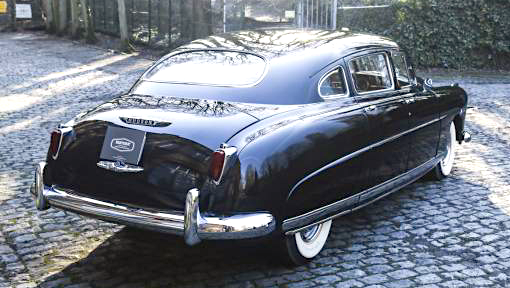Those '48 Hudsons were distinctly different from competing brands. Besides a streamlined-appearing shape, they were lower than competing cars in part due to the use of unitized bodies rather than conventional body-on frame. For example, 1947 Hudson height was 68 inches (1727 mm), the new, competing 1948 Oldsmobile 98's height was 63.8 inches (1621 mm), and the 1948 Hudson Commodore was only 60.375 inches (1534 mm) high. All these cars had road clearances of approximately 8 inches (203 mm).
The Gallery below features walkaround views of a line-leader Hudson Commodore sedan along with images of other cars mentioned above.
1947 Hudson Commodore Sedan - for-sale photo
The previous Hudson design. At its core is a 1936 model year body that experienced many facelifts over the years. Its grille design has some features that were carried over to the 1948 model (horizontal bars and the upper frame theme). Otherwise, all was changed.
Factory photo of a 1948 Hudson Sedan
General view of a '48 Hudson.
1948 Oldsmobile 98 - factory photo
An example of styling leader General Motors' redesigned for 1948 C-body 4-door sedans. This was the new postwar American industry norm. The new Hudsons were quite different.
1948 Hudson Commodore sedan - for-sale photos
Now for the walkaround. As mentioned, the grille theme retained some features from 1947 Hudsons.
Postwar American redesigns featured flow-through fenderlines. The result sometimes resulted in a slab-sided appearance. Hudson's low height eliminated that possibility.
Even so, stylists took a few steps to visually reduce a slab look. The fenderline is slightly below the passenger compartment greenhouse beltline. Also, there is a character line crease partway down the fender. The result is that the side looks sleek.
Rear ends were simple in those days.
The backlight window has curved glass, but its area is not very large because curved glass technology was not quite ready for larger sizes. Note the curved plan form of the passenger compartment roof.
The broad chrome strip along the base of the body might have helped to draw viewers' eyes downward, helping to give Hudsons a low appearance.
Again, glass forming limited the windshield to two sections and not a unrestricted panorama. The Oldsmobile pictured above also had a two-piece windshield.










3 comments:
Actually, they did have a frame of sorts but it was welded to the body, sort of like some 1930's cars. (Airflows, Zephyrs?). The rails ran outside the rear wheels so they had to be skirted (check the 1948 brochure). As I think you have written, Nash and Hudson spent a lot of money on postwar cars that were the future in 1940 but turned out not to be by 1950. The slot-like side windows didn't help.
The called it Monobilt body-and-frame.
I believe unitized is a fairly correct term because while it's definitely not a uni-body it's a pretty integrated structure with the exception of the front sub-frame. I really can't say it's body on frame either especially the 54's with there welded in rear fenders.
Post a Comment